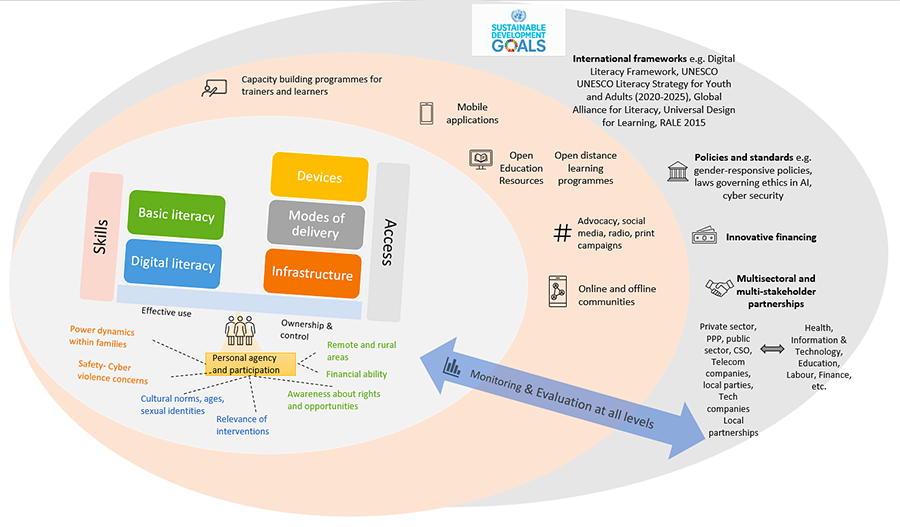The move to online learning during the pandemic has disadvantaged women who typically have less access to online and digital technology than men. As the world marks International Women’s Day, Annapurna Ayyappan and Samah Shalaby reflect on how we might begin bridging this divide

This year, International Women’s Day falls at a critical time, as the world confronts the unprecedented educational challenges of the COVID-19 crisis. To ensure learning continuity, most of the world has rapidly adopted emergency approaches, particularly through a shift to online learning. However, a large number of learners are still being left behind. While the shift to online has demonstrated the usefulness of technology in advancing learning opportunities, it has also revealed gaps in education systems, including in non-formal adult education. This post highlights one particular gap which jeopardizes equitable access to learning and the empowerment of half the world’s population – the gender digital divide.
Worldwide, women are less likely to know how to operate a smartphone, navigate the internet, use social media and understand how to safeguard information in digital media. This lack of digital skills is apparent from the lowest skill proficiency levels, such as using applications on mobile phones to the advanced skills such as coding computer software. In addition to the lack of digital skills, women are confronted with various barriers to digital access, such as affordability, social and cultural norms, financial independence, and cyber safety. This lack of access and skills is more severe among the women who are older and/or less educated than their peers, poor, or living in rural areas and developing countries. Thus, the digital skills gap intersects with, and is compounded by, issues of poverty and educational access.
Lack of literacy and numeracy skills are interconnected with low digital skills. In other words, a lack of literacy skills prevents women from fully accessing and using digital tools and benefiting from digital learning opportunities. In rural India, for example, a study found that the majority of women who owned mobile phones only knew how to answer calls; they could not dial numbers or read messages without assistance from their husbands, due to a lack of literacy and numeracy skills.
To realize a balanced relationship between access and skills (literacy, numeracy and digital skills), an effective approach must be situated within well-articulated gender-responsive education systems that support lifelong learning. The purpose of this post, therefore, is our attempt to map and put together, as shown in the figure below, the elements that could help to increase women’s participation in digital learning and narrow the gender digital divide.

Acknowledging the pivotal role of learners, in this case girls and women, as partners and agents of change means placing them at the centre of education systems and programmes. Learners’ personal agency and empowerment can play a major role in the ownership, control and effective use of digital tools for learning and other purposes.
In order to encourage women’s participation in digital learning, learning programmes and materials should be contextualized based on their needs and aspirations. This would necessitate developing appropriate content and modes of delivery (online, offline and hybrid), and open educational resources. Well-planned capacity-building programmes for facilitators as well as flexible and cyber-safe learning opportunities are also essential for women to participate in digital learning and successfully attain digital competences.
Global frameworks can guide coordinated gender-responsive policies and actions to regulate the practice and the use of digital learning. For example, the UNESCO Strategy for Youth and Adult Literacy (2020–2025) recognizes and calls for support to Member States to leverage digital technologies, with a strong focus on gender equality as one of its strategic pillars. Implementing policies and ensuring equitable access to ICT require innovative financing and solid governance mechanisms that bring on board all the relevant stakeholders from different sectors such as civil society organizations, the private sector (IT and telecommunication companies), and national and local actors. In order to make education systems and the digital learning for women more responsive, women should be well-represented in the development of learning and education policies, in governance, and in the development and design of learning materials and learning applications.
When planning for such a transversal approach, monitoring and evaluation mechanisms have to be implemented systemically. The UNESCO Institute for Statistics has developed a set of disaggregated data on the proportion of youth and adults with information and communications technology (ICT) skills, by type of skill (UIS data, Sustainable Development Target 4.4). Building on this in connection with education and learning indicators can support countries in tracking progress in participation in relation to using ICTs. At the level of the learners and facilitators using digital tools for learning, the Learning Management System (a software application), can be drawn on for planning and executing learning programmes, also enabling self-assessment and tracking learning progress.
Bridging the gender digital divide can accelerate global economic growth, and support the implementation of the 2030 Agenda for Sustainable Development. However, the efforts towards narrowing the digital gender gap must go beyond addressing immediate practical needs at the level of the learners – it should be embedded within flexible and permeable gender-responsive education systems.
Annapurna Ayyappan and Samah Shalaby are assistant programme specialists at the UNESCO Institute for Lifelong Learning
